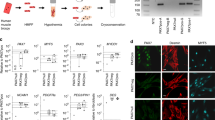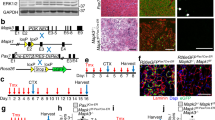Abstract
Myoblast transplantation is a potential therapeutic approach for the genetic modification of host skeletal muscle tissue. To be considered an effective, long-lived method of delivery, however, it is essential that at least a proportion of the transplanted cells also retain their proliferative potential. We sought to investigate whether transplanted neonatal myoblasts can contribute to the satellite cell compartment of adult skeletal muscle by using the Myf5nlacZ/+ mouse. The Myf5nlacZ/+ mouse has nlacZ targeted to the Myf5 locus resulting in β-galactosidase activity in quiescent satellite cells. Following transplantation, β-galactosidase-labelled nuclei were detected in host muscles, showing that donor cells had been incorporated. Significantly, β-galactosidase-positive, and therefore donor-derived, satellite cells were detected. When placed in culture, β-galactosidase marked myogenic cells emanated from the parent fibre. These observations demonstrate that cell transplantation not only results in the incorporation of donor nuclei into the host muscle syncytia, but also that the donor cells can become functional satellite cells. The Myf5nlacZ/+ mouse therefore provides a novel and specific marker for determining the contribution of transplanted cells to the satellite cell pool.
This is a preview of subscription content, access via your institution
Access options
Subscribe to this journal
Receive 12 print issues and online access
$259.00 per year
only $21.58 per issue
Buy this article
- Purchase on Springer Link
- Instant access to full article PDF
Prices may be subject to local taxes which are calculated during checkout



Similar content being viewed by others
References
Mauro A . Satellite cell of skeletal muscle fibers J Biophys Biochem Cytol 1961 9: 493–496
Katz B . The terminations of the afferent nerve fibre in the muscle spindles of the frog Philos Trans Roy Soc B 1961 243: 221–240
Moss FP, Leblond CP . Satellite cells as the source of nuclei in muscles of growing rats Anat Rec 1971 170: 421–436
Schultz E, Gibson MC, Champion T . Satellite cells are mitotically quiescent in mature mouse muscle: an EM and radioautographic study J Exp Zool 1978 206: 451–456
Walker BE . Skeletal muscle regeneration in young rats Am J Anat 1972 133: 369–378
Snow MH . Origin of regenerating myoblasts in mammalian skeletal muscle. In: Mauro A (ed) Muscle Regeneration Raven Press: New York 1979 pp 91–100
Partridge TA et al. Conversion of mdx myofibres from dystrophin-negative to -positive by injection of normal myoblasts Nature 1989 337: 176–179
Hoffman EP, Brown R, Kunkel LM . Dystrophin: the protein product of the Duchenne muscular dystrophy locus Cell 1987 51: 919–928
Bulfield G, Siller WG, Wight PAL, Moore KJ . X chromosome-linked muscular dystrophy (mdx) in the mouse Proc Natl Acad Sci USA 1984 81: 1189–1192
Tajbakhsh S, Rocancourt D, Buckingham M . Muscle progenitor cells failing to respond to positional cues adopt non-myogenic fates in myf-5 null mice Nature 1996 384: 266–270
Tajbakhsh S, Buckingham M . The birth of muscle progenitor cells in the mouse: spatiotemporal considerations Curr Topics Dev Biol 2000 48: 225–268
Rudnicki MA et al. MyoD or Myf-5 is required for the formation of skeletal muscle Cell 1993 75: 1351–1359
Beauchamp JR et al. Expression of CD34 and Myf5 defines the majority of quiescent adult skeletal muscle satellite cells J Cell Biol 2000 151: 1221–1233
Cooper RN et al. In vivo satellite cell activation via Myf5 and MyoD in regenerating mouse skeletal muscle J Cell Sci 1999 112: 2895–2901
Donoghue M, Merlie JP, Rosenthal N, Sanes JR . A rostrocaudal gradient of transgene expression in adult skeletal muscle Proc Natl Acad Sci USA 1991 88: 5847–5851
Rosenblatt JD, Parry DJ . Gamma irradiation prevents compensatory hypertrophy of overloaded mouse extensor digitorum longus muscle J Appl Physiol 1992 73: 2538–2543
Rosenblatt JD, Lunt AI, Parry DJ, Partridge TA . Culturing satellite cells from living single muscle fiber explants In Vitro Cell Dev Biol 1995 31: 773–779
Yang J et al. Limitations of nlsβ-galactosidase as a marker for studying myogenic lineage or the efficacy of myoblast transfer Anat Rec 1997 248: 40–50
Wakeford S, Watt DJ, Partridge TA . X-irradiation improves mdx mouse muscle as a model of myofiber loss in DMD Muscle Nerve 1991 14: 42–50
Morgan JE, Pagel CN, Sherrrratt T, Partridge TA . Long-term persistence and migration of myogenic cells injected into pre-irradiated muscles of mdx mice J Neurol Sci 1993 115: 191–200
Gross JG, Morgan JE . Muscle precursor cells injected into irradiated mdx mouse muscle persist after serial injury Muscle Nerve 1999 22: 174–185
Yao S-N, Kurachi K . Implanted myoblasts not only fuse with myofibers but also survive as muscle precursor cells J Cell Sci 1993 105: 957–963
Morgan JE et al. Myogenic cell lines derived from transgenic mice carrying a thermolabile T antigen: a model system for the derivation of tissue-specific and mutation-specific cell lines Dev Biol 1994 162: 486–498
Blaveri K et al. Patterns of repair of dystrophic mouse muscle: studies on isolated fibers Dev Dynam 1999 216: 244–256
Weller B, Karpati G, Lehnert S, Carpenter S . Major alteration of the pathological phenotype in gamma irradiated mdx soleus muscles J Neuropathol Exp Neurol 1991 50: 419–431
Heslop L, Morgan JE, Partridge TA . Evidence for a myogenic stem cell that is exhausted in dystrophic muscle J Cell Sci 2000 113: 2299–2308
Ferrari G et al. Muscle regeneration by bone marrow-derived myogenic progenitors Science 1998 279: 1528–1530
Gussoni E et al. Dystrophin expression in the mdx mouse restored by stem cell transplantation Nature 1999 410: 390–394
Jackson KA, Mi T, Goodell MA . Hematopoietic potential of stem cells isolated from murine skeletal muscle Proc Natl Acad Sci USA 1999 96: 14482–14486
Watt DJ et al. Incorporation of donor muscle precursor cells into an area of muscle regeneration in the host mouse J Neurol Sci 1982 57: 319–331
Bekoff A, Betz WJ . Physiological properties of dissociated muscle fibres obtained from innervated and denervated adult rat muscle J Physiol 1977 271: 25–40
Bischoff R . Proliferation of muscle satellite cells on intact myofibers in culture Dev Biol 1986 115: 129–139
Sanes JR, Rubenstein JLR, Nicolas J-F . Use of a recombinant retrovirus to study post-implantation cell lineage in mouse embryos EMBO J 1986 5: 3133–3142
Acknowledgements
This work was supported by EC Contract QLK3-1999-00020, EC Biotechnology Grant BIO4 CT 95–0228 and The British Council/EGIDE Alliance 2000/2001 grant PN 00.172. The Muscle Cell Biology Group was supported by The Medical Research Council, EC Biotechnology Grants BIO4 CT95–0284 and BMH4 CT97–2767. MB's laboratory was supported by grants from the Pasteur Institute, CNRS, Association Française contre les Myopathies and Ministère des Sciences et Technologies. PZ and LH were also supported by the Leopold Muller Foundation and ST by a grant from the HFSPO. We would like to thank Robert Kelly for invaluable help, and Graham Reed and Richard Newton in the MRC CSC Photography department.
Author information
Authors and Affiliations
Rights and permissions
About this article
Cite this article
Heslop, L., Beauchamp, J., Tajbakhsh, S. et al. Transplanted primary neonatal myoblasts can give rise to functional satellite cells as identified using the Myf5nlacZl+ mouse. Gene Ther 8, 778–783 (2001). https://doi.org/10.1038/sj.gt.3301463
Received:
Accepted:
Published:
Issue Date:
DOI: https://doi.org/10.1038/sj.gt.3301463
Keywords
This article is cited by
-
The muscle satellite cell at 50: the formative years
Skeletal Muscle (2011)
-
In vivo Fluorescence Imaging of Muscle Cell Regeneration by Transplanted EGFP-labeled Myoblasts
Molecular Therapy (2010)
-
Intramuscular Transplantation of Human Postnatal Myoblasts Generates Functional Donor-Derived Satellite Cells
Molecular Therapy (2010)
-
Another New “Super Muscle Stem Cell” Leaves Unaddressed the Real Problems of Cell Therapy for Duchenne Muscular Dystrophy
Molecular Therapy (2008)



